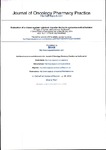Evaluation of a closed-system cytotoxic transfer device in a pharmaceutical isolator
| dc.contributor.author | Vyas, N | |
| dc.contributor.author | Turner, Andrew | |
| dc.contributor.author | Clark, JM | |
| dc.contributor.author | Sewell, GJ | |
| dc.date.accessioned | 2015-10-27T16:01:59Z | |
| dc.date.available | 2015-10-27T16:01:59Z | |
| dc.date.issued | 2016-02 | |
| dc.identifier.issn | 1078-1552 | |
| dc.identifier.issn | 1477-092X | |
| dc.identifier.uri | http://hdl.handle.net/10026.1/3699 | |
| dc.description.abstract |
<jats:sec><jats:title>Purpose</jats:title><jats:p> The occupational risk associated with handling of cytotoxic anticancer drugs is well documented and, in many countries, pharmaceutical isolators are used to contain cytotoxic residues during preparation of cytotoxic infusions. Isolators are difficult to clean leading to concerns that cytotoxic contamination from the work area could be transferred to surfaces of products leaving the isolator. This study investigated the surface contamination arising from the preparation of five anticancer drug infusions (Epirubicin, Fluorouracil, Cisplatin, Oxaliplatin and Carboplatin) in a pharmaceutical isolator and compared use of a conventional syringe and needle technique with a closed-system drug transfer device (CSDTD). </jats:p></jats:sec><jats:sec><jats:title>Methods</jats:title><jats:p> Wipe samples were taken over 1 week from pre-defined areas in the isolator, gloves, preparation mats, and also from the surfaces of prepared cytotoxic infusion bags and pre-filled syringes to obtain baseline surface contamination data. Following operator familiarisation, the CSDTD was then introduced and sampling repeated for a further week ( intervention period). The samples obtained were analysed using validated HPLC-UV, HPLC-FL and ICP-MS techniques, as appropriate. </jats:p></jats:sec><jats:sec><jats:title>Results</jats:title><jats:p> All surfaces sampled during baseline, including external surfaces of infusions and syringes, were contaminated with each marker drug. During the intervention phase, isolator surfaces were free from detectable contamination and the contamination measured on gloves, preparation mats and surface of infusions was markedly reduced. The frequency of contamination on syringe and infusion surfaces was also lower. </jats:p></jats:sec><jats:sec><jats:title>Conclusion</jats:title><jats:p> Surface contamination from cytotoxic infusion preparation in a pharmaceutical isolator was significant and could transmit cytotoxic residues to patient and public areas via infusion surfaces. The frequency and amount of contamination were reduced by the CSDTD. </jats:p></jats:sec> | |
| dc.format.extent | 10-19 | |
| dc.format.medium | Print-Electronic | |
| dc.language | en | |
| dc.language.iso | eng | |
| dc.publisher | SAGE Publications | |
| dc.subject | Cytotoxic drugs | |
| dc.subject | cancer chemotherapy | |
| dc.subject | closed-system drug transfer device | |
| dc.subject | pharmaceutical isolator | |
| dc.subject | surface contamination | |
| dc.subject | Antineoplastic Agents | |
| dc.subject | Environmental Monitoring | |
| dc.subject | Equipment Contamination | |
| dc.subject | Occupational Exposure | |
| dc.subject | Pharmacy | |
| dc.subject | Pharmacy Service, Hospital | |
| dc.subject | Protective Devices | |
| dc.subject | Syringes | |
| dc.title | Evaluation of a closed-system cytotoxic transfer device in a pharmaceutical isolator | |
| dc.type | journal-article | |
| dc.type | Journal Article | |
| plymouth.author-url | https://www.ncbi.nlm.nih.gov/pubmed/25073678 | |
| plymouth.issue | 1 | |
| plymouth.volume | 22 | |
| plymouth.publication-status | Published | |
| plymouth.journal | Journal of Oncology Pharmacy Practice | |
| dc.identifier.doi | 10.1177/1078155214544993 | |
| plymouth.organisational-group | /Plymouth | |
| plymouth.organisational-group | /Plymouth/Faculty of Health | |
| plymouth.organisational-group | /Plymouth/Faculty of Science and Engineering | |
| plymouth.organisational-group | /Plymouth/Faculty of Science and Engineering/School of Geography, Earth and Environmental Sciences | |
| plymouth.organisational-group | /Plymouth/REF 2021 Researchers by UoA | |
| plymouth.organisational-group | /Plymouth/REF 2021 Researchers by UoA/UoA03 Allied Health Professions, Dentistry, Nursing and Pharmacy | |
| plymouth.organisational-group | /Plymouth/REF 2021 Researchers by UoA/UoA03 Allied Health Professions, Dentistry, Nursing and Pharmacy/UoA03 Allied Health Professions, Dentistry, Nursing and Pharmacy MANUAL | |
| plymouth.organisational-group | /Plymouth/REF 2021 Researchers by UoA/UoA07 Earth Systems and Environmental Sciences | |
| plymouth.organisational-group | /Plymouth/Research Groups | |
| plymouth.organisational-group | /Plymouth/Research Groups/BEACh | |
| plymouth.organisational-group | /Plymouth/Research Groups/Institute of Health and Community | |
| plymouth.organisational-group | /Plymouth/Research Groups/Marine Institute | |
| plymouth.organisational-group | /Plymouth/Users by role | |
| plymouth.organisational-group | /Plymouth/Users by role/Academics | |
| dc.publisher.place | England | |
| dc.identifier.eissn | 1477-092X | |
| dc.rights.embargoperiod | Not known | |
| rioxxterms.versionofrecord | 10.1177/1078155214544993 | |
| rioxxterms.licenseref.uri | http://www.rioxx.net/licenses/all-rights-reserved | |
| rioxxterms.type | Journal Article/Review |


